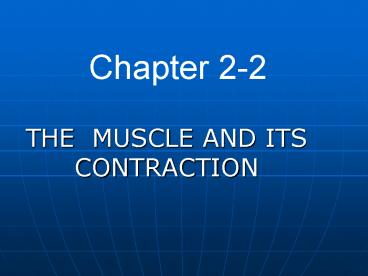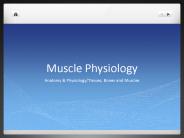THE MUSCLE AND ITS CONTRACTION - PowerPoint PPT Presentation
1 / 26
Title: THE MUSCLE AND ITS CONTRACTION
1
Chapter 2-2
- THE MUSCLE AND ITS CONTRACTION
2
- the Neuromuscular Junction (NMJ)
3
Skeletal Muscle Innervation
4
Illustration of the Neuromuscular Junction (NMJ)
5
New Ion Channel Players
- Voltage-gated Ca2 channel
- in presynaptic???? nerve terminal
- mediates neurotransmitter release
- Nicotinic Acetylcholine???? Receptor Channel
- in muscle neuromuscular junction
(postsynaptic???? membrane, or end plate) - mediates electrical transmission from nerve to
muscle
6
Nerve Terminal Ca2 channels
- Structurally similar to Na channels
- Functionally similar to Na channels except
- activation occurs at more positive potentials
- activation and inactivation much slower than Na
channels
7
Neuromuscular Transmission
Myelin
Axon
Axon Terminal
Skeletal Muscle
8
Neuromuscular Transmission Step by Step
Depolarization??? of terminal opens Ca channels
Nerve action potential invades axon terminal
9
Ca2 induces fusion?? of vesicles with
nerve terminal membrane.
ACh is released and Diffuses?? across synaptic
cleft.
Nerve terminal
Binding of ACh opens channel pore that
is permeable to Na and K.
K
K
K
K
K
Outside
Muscle membrane
Inside
ACh binds to its receptor on the postsynaptic
membrane
K
K
K
K
K
K
K
K
10
End Plate Potential (EPP)
VNa
The movement of Na and K depolarizes muscle
membrane potential (EPP)
0
Muscle Membrane Voltage (mV)
Threshold
Presynaptic terminal
-90 mV
VK
Time (msec)
Presynaptic AP
Outside
Muscle membrane
Inside
Voltage-gated Na Channels
ACh Receptor Channels
Inward Rectifier K Channels
11
Structural Reality
12
Neuromuscular Transmission
- Properties?? of neuromuscular junction
- 11 transmission A chemical transmission which
is designed to assure that every presynaptic
action potential results in a postsynaptic one - An unidirectional??? process
- Has a time delay. 20nm/0.5-1ms
- Is easily affect by drugs and some factors
- The NMJ is a site of considerable clinical
importance
13
NMJ Diseases
- Myasthenia Gravis (?????)
- Autoimmunity to ACh receptor
- Fewer functional ACh receptors
- Low safety factor for NM transmission
- Lambert-Eaton syndrome(???-????? ,???????? )
- Autoimmunity directed against Ca2 channels
- Reduced ACh release
- Low safety factor for NM transmission
14
Microstructure of Skeletal Muscle
15
Skeletal Muscle
- Human body contains over 400 skeletal muscles
- 40-50 of total body weight
- Functions of skeletal muscle
- Force production for locomotion?? and breathing
- Force production for postural?? support
- Heat production during cold stress
16
- Fascicles?? bundles, CT(connective tissue????)
covering on each one - Muscle fibers muscle cells
17
Structure of Skeletal MuscleMicrostructure
- Sarcolemma (????)
- Transverse (T) tubule
- Longitudinal tubule (Sarcoplasmic reticulum, SR
???) - Myofibrils (????)
- Actin ???? (thin filament)
- Troponin (????)
- Tropomyosin (?????)
- Myosin ???? (thick filament)
18
Within the sarcoplasm
Triad (???)
- Transverse tubules
- Sarcoplasmic reticulum -Storage sites for calcium
- Terminal cisternae - Storage sites for calcium
19
Microstructure of Skeletal Muscle (myofibril)
20
Sarcomeres
- Sarcomere ??? bundle of alternating thick and
thin filaments - Sarcomeres join end to end to form myofibrils
- Thousands per fiber, depending on length of
muscle - Alternating thick and thin filaments create
appearance of striations??
21
(No Transcript)
22
Myosin ????
- Myosin head is hinged??
- Bends and straightens during contraction
23
Thick filaments (myosin)
- Bundle of myosin proteins shaped like
double-headed golf clubs - Myosin heads have two binding sites
- Actin binding site forms cross bridge
- Nucleotide??? binding site binds ATP (Myosin
ATPase) - Hydrolysis?? of ATP provides energy to generate
power stroke
24
Thin filaments
?????
????
????
25
Thin filaments (actin)
- Backbone two strands of polymerized globular
actin fibrous actin - Each actin has myosin binding site
- Troponin
- Binds Ca2 regulates muscle contraction
- Tropomyosin
- Lies in groove of actin helix
- Blocks myosin binding
- sites in absence of Ca2
26
- Thick filament Myosin (head and tail)
- Thin filament Actin, Tropomyosin, Troponin
(calcium binding site)































